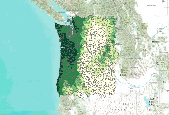Filters: Tags: NPP (X)
6 results (9ms)|
Filters
Contacts
(Less)
|

This dataset represents the average net primary production for each HUC5 watershed, simulated by the model MC1 for the 30-year period 1971-2000. Mean net primary production (in g m-2 per yr), was determined for each HUC5 watershed by averaging values of original ~ 4 km raster data. Watersheds represent 5th level (HUC5, 10-digit) hydrologic unit boundaries and were acquired from the Natural Resources Conservation Service. Background: The dynamic global vegetation model MC1 (see Bachelet et al.2001) was used to simulate vegetation dynamics, associated carbon and nitrogen cycle, water budget, and wild fire impacts for OR, WA, AZ and NM, for a project funded by the USDA Forest Service (PNW09-JV-11261900-003). The MC1...

NPP—the net amount of solar energy converted to plant organic matter through photosynthesis—can be measured in units of elemental carbon and represents the primary food energy source for the world's ecosystems. Human appropriation of net primary productivity (HANPP), through the consumption of food, paper, wood and fiber, alters the composition of the atmosphere, levels of biodiversity, energy flows within food webs and the provision of important ecosystem services.
This dataset represents the average net primary production for each HUC5 watershed, simulated by the model MC1 for the 30-year period 1971-2000. Mean net primary production (in g m-2 per yr), was determined for each HUC5 watershed by averaging values of original ~ 4 km raster data. Watersheds represent 5th level (HUC5, 10-digit) hydrologic unit boundaries and were acquired from the Natural Resources Conservation Service. Background: The dynamic global vegetation model MC1 (see Bachelet et al.2001) was used to simulate vegetation dynamics, associated carbon and nitrogen cycle, water budget, and wild fire impacts for OR, WA, AZ and NM, for a project funded by the USDA Forest Service (PNW09-JV-11261900-003). The...

NPP—the net amount of solar energy converted to plant organic matter through photosynthesis—can be measured in units of elemental carbon and represents the primary food energy source for the world's ecosystems. Human appropriation of net primary productivity (HANPP), through the consumption of food, paper, wood and fiber, alters the composition of the atmosphere, levels of biodiversity, energy flows within food webs and the provision of important ecosystem services.

NPP—the net amount of solar energy converted to plant organic matter through photosynthesis—can be measured in units of elemental carbon and represents the primary food energy source for the world's ecosystems. Human appropriation of net primary productivity (HANPP), through the consumption of food, paper, wood and fiber, alters the composition of the atmosphere, levels of biodiversity, energy flows within food webs and the provision of important ecosystem services.
Improving the quality of habitat for western big-game species, such as elk and mule deer, was identified as a priority by the Department of the Interior in 2018. Maintaining healthy herds not only supports the ecosystems where these species are found, but also the hunting and wildlife watching communities. For example, in Wyoming, big game hunting contributed over $300 million to the state’s economy in 2015. Yet as climate conditions change, the quantity, quality, and timing of vegetation available to mule deer, elk, and other ungulates, known as forage, could shift. It’s possible that these changes could have cascading impacts on the behavior and population sizes of many species. A key strategy used by managers...
Categories: Project;
Types: Map Service,
OGC WFS Layer,
OGC WMS Layer,
OGC WMS Service;
Tags: 2018,
CASC,
Completed,
EVI,
IRG,
|

|